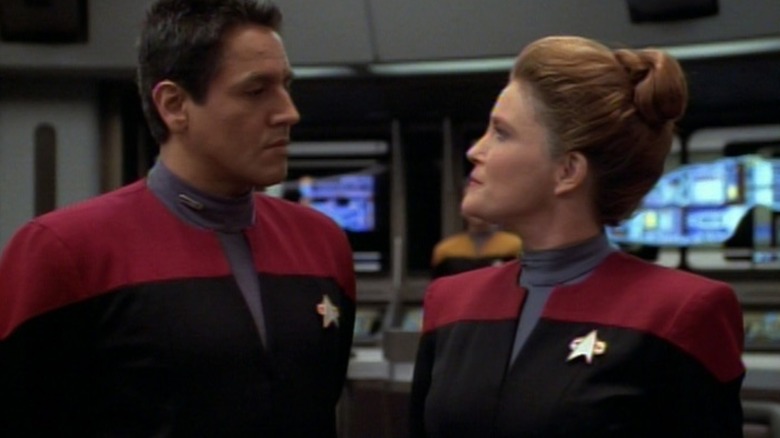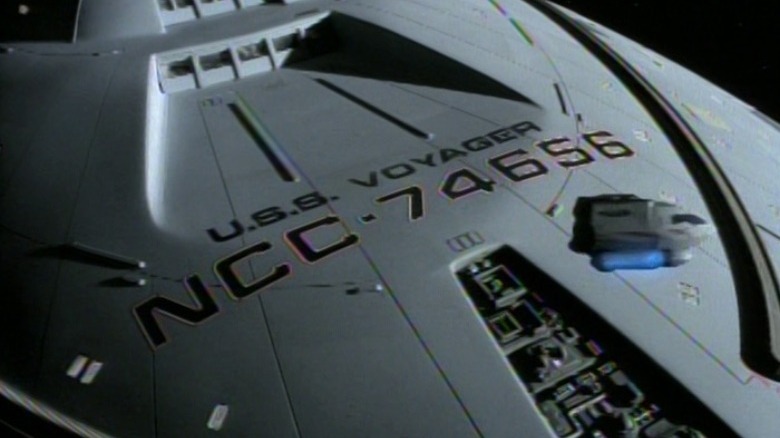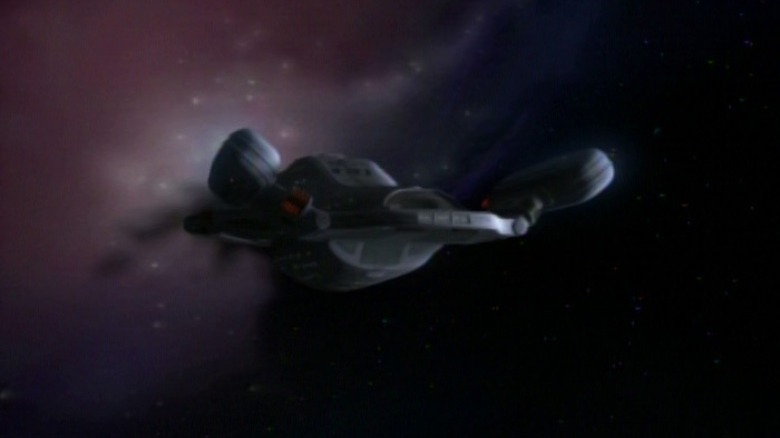The premise of “Star Trek: Voyager” was full of promise. In the pilot episode, “Caretaker,” the title ship is assigned to apprehend a rogue vessel piloted by a terrorist group called the Maquis. The Maquis were an anti-Federation group that resented the organization’s clumsy diplomacy, and tendency to kowtow to violent species like the Cardassians. The Maquis played a small role in late episodes of “Star Trek: The Next Generation” and on “Star Trek: Deep Space Nine,” and they provided a tantalizing philosophical counterpoint to Gene Roddenberry’s utopian future; we seem to be living in a universe without want, and the Federation seems to exist to provide equity to the galaxy, but there are still many people who aren’t getting what they need. The Maquis aimed to rectify that.
During the scuffle, the U.S.S. Voyager and the Maquis ship are both unexpectedly whisked clear across the galaxy by a godlike alien being. The whisking damages both ships and the Maquis have to transport to the Voyager to survive. Now both crews are stranded 70 years from Earth, forced to live together on a ship with a limited crew and no access to renewable resources.
This was a premise ripe for drama, as it came with the interpersonal conflict baked in. The Starfleet officers and the Maquis would constantly butt heads, but neither group could abandon the other, as they needed one another’s know-how and elbow grease. Over the course of the series, audiences would see if the desperate, lonely situation would force the two crews together, or drive them to antagonism.
Writer Ron D. Moore, however, felt that anything exciting about the above premise was abandoned almost immediately. In the oral history book “The Fifty-Year Mission: The Next 25 Years: From The Next Generation to J. J. Abrams,” edited by Mark A. Altman and Edward Gross, Moore went on the record with how all of the show’s potential drama was essentially solved at the end of the pilot. Any drama between the Maquis and Starfleet was instantly laid to rest.
The Maquis vs. Starfleet
By the end of “Caretaker,” Captain Janeway (Kate Mulgrew) had come up with a novel solution to the potential headbutting between the Maquis and the Starfleet officers. She gave a field commission to the Maquis commander Chakotay (Robert Beltran) and made one of their most skilled engineers (Roxann Dawson) the Chief Engineer of the Voyager. Several other Maquis officers were also given uniforms and asked to serve as officers on board the ship.
Sadly, there weren’t too many episodes, post-pilot, exploring how the Maquis felt about that. There were a few mentions of the Maquis here and there, but it was all eventually abandoned, with Janeway overseeing a crew that she insisted was a family. Chakotay was so diplomatic, that there didn’t seem to be any conflict at all. The Maquis seemed a little too eager to put on the Starfleet uniforms they previously claimed to hate, and everyone fell back on a very usual “Star Trek” routine. The idea of two enemy groups relying on each other for survival in deep space seemed to evaporate. At least, that’s how Moore felt. He said:
“When the Maquis put on those Starfleet uniforms at the end of the pilot, the show was dead. That was the biggest mistake, because they went through this whole thing to bring on their enemies. […] Here are Starfleet officers who had become terrorist resistance fighters, guerrilla warriors. The Federation has got them on the run and both of these groups are thrown in a ship on another side of the galaxy and forced to live together. You’d think that’s the setup for a major show about conflict, but at the end of the pilot they all put on the Starfleet uniforms and that’s it.’
Gene Roddenberry may have appreciated the lack of conflict — he famously forbade interpersonal fights on “Star Trek: The Next Generation” — but none of the writers felt they had anything to work with.
Let’s not make it dark
One might think that the Maquis, even if they reluctantly accepted positions on the U.S.S. Voyager, would have been a lot angrier at Captain Janeway, as it was her decisions that left everyone stranded way out in the Delta Quadrant. It was brought up a few times, but it was, however, never a major source of drama. Moore felt many, many stories could have been mined from the baked-in resentment of the show’s premise. Instead, the Maquis skipped to the part of the series — that should have logically come several years into the series — when they put on uniforms.
Moore felt this was due to fear. “Deep Space Nine” was a darker show than its predecessor, “Next Generation,” and it wasn’t nearly as successful. Making another dark show about political enemies wasn’t making anyone comfortable. Moore continued:
“It was a huge mistake. It should have been these two sides that were forced to work together that still don’t like each other and still are gunning for each other, wondering who’s going to come out on top. Who’s going to betray who? It should have been gold, but [the showrunners] got scared. Unfortunately, the fact that DS9 didn’t do as well as NextGen scared them and they didn’t want another dark show that wasn’t as successful. They wanted a show that was more like ‘Next Generation’ and easier to swallow and where people didn’t have to think as much.”
He said that everyone learned “the wrong lessons and said, ‘Let’s play it safe.'”
As “Voyager” continued, even the idea of resource scarcity fell away. The ship never ran out of supplies, everyone was always well-fed, and it had enough energy to have the holodeck running 24/7. All the tantalizing ideas of conflict and resource management were pretty much abandoned, and the series settled into a pretty typical “Star Trek” series.
Moore, meanwhile, took a lot of what he wanted to do with “Voyager,” left the series, and launched his own TV show, the new “Battlestar Galactica.”










